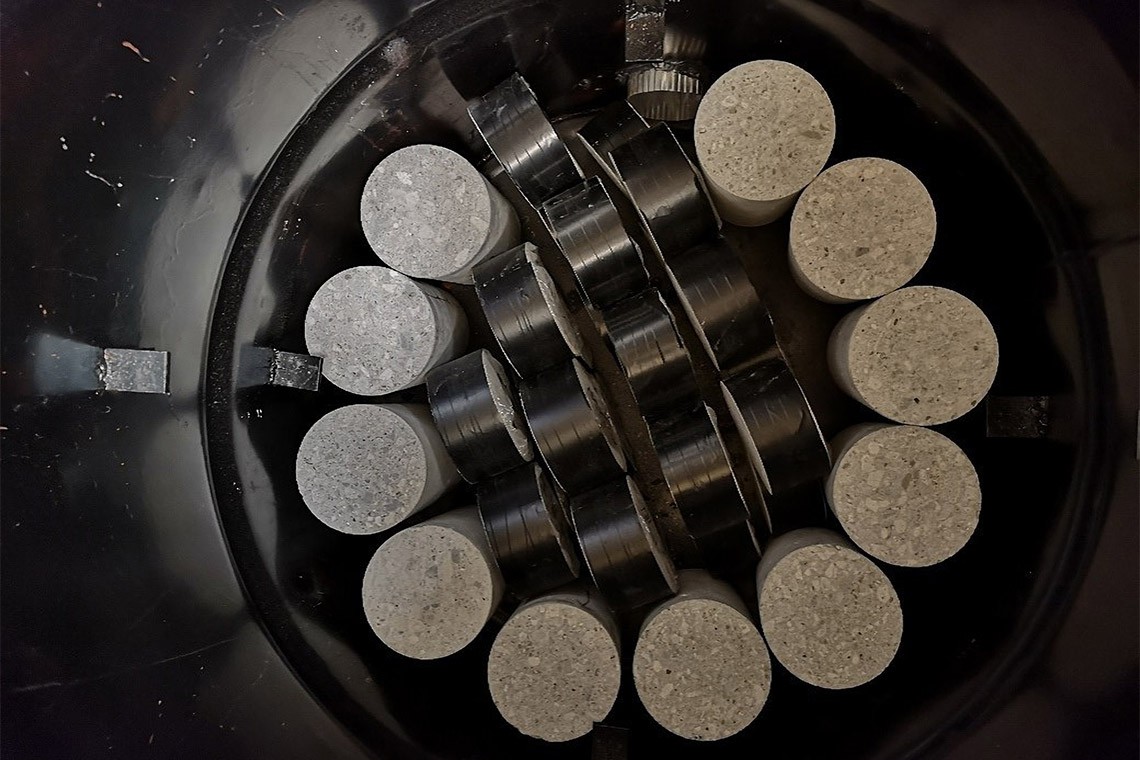Toronto team investigates burying carbon in concrete
The research project is supported by $1.7 million in federal funding.

Samples of concrete cure in a carbonation chamber. – Runxiao Zhang
Key Takeaways:
- Researchers in Toronto will test the viability of various methods of trapping CO2 in concrete.
- It is a collaboration between University of Toronto and the Canada Green Building Council.
- Officials say the collaboration will make it easier for research findings to get translated into industry, as well as into new policies and regulations.
The Whole Story:
Where do you put carbon once you capture it?
Researchers in Toronto are investigating the potential of burying it into one of the world’s most common products: concrete.
The work is a collaboration between a team of researchers led by Daman Panesar, a professor in the University of Toronto’s department of civil and mineral engineering in the Faculty of Applied Science & Engineering, and the Canada Green Building Council (CAGBC). The team will identify the potential and implications of low-carbon approaches and technologies and how they might capture large amounts of CO2 and trap it in concrete.
The project is funded by a $1.7 million contribution by the Government of Canada.
“Currently, several low-carbon concrete framework documents have been produced worldwide and most of these roadmaps have set 2050 carbon reduction targets related to several levers, such as clinker-cement ratio, alternative fuel use and carbon capture, storage and sequestration,” said Panesar.
The researchers noted that while there has been preliminary work on several carbon utilization approaches, few have been implemented on a large scale. Panesar and her team will examine the challenges associated with scale-up of these strategies and explore new technologies that can effectively turn built infrastructure into a carbon sink.
“Natural carbonation of concrete occurs by a chemical reaction between the constituents of concrete, particularly cement, and atmospheric carbon dioxide – and it has the potential to occur throughout the life of the concrete,” said Panesar. “However, accelerated or enforced carbonation approaches are relatively new technologies, which can also be referred to as carbon capture and utilization technologies, and can be introduced at different life stages such as during manufacture or at end-of-life.”
Some examples of processes that will be explored and assessed include:
- CO2 injection
- Elevated CO2 exposure
- Mineral carbonation using recycled or waste CO2
- Industry by-products used to replace cement and subsequent CO2 curing
- Synthetic treated aggregates
“All of these techniques need further understanding of the implications and potential for negative emission technologies such as carbon capture utilization approaches,” Panesar says.
The researchers explained that another challenge for both new and existing structures is ensuring that any change to the formulations of concrete – for example, using lower-carbon components or absorbing more CO2 during curing – doesn’t come at the expense of its required structural and material design properties, including strength and durability.
“For example, considering natural carbonation processes, the mechanism related to the potential for increased vulnerability of reinforced concrete elements to steel corrosion, concrete degradation and shortened service lives is fairly well understood.” said Panesar.
“For existing infrastructure, the situation becomes more complex because there is a need to account for and interpret the role of age-related cracking on the CO2 uptake of concrete, as well as in conjunction with other predominant degradation issues in Canada, such as freeze-thaw cycles.”
Finally, researchers stressed that there is a need to develop benchmarks and other standardized tools to accurately account for the carbon uptake in building materials.
“Currently, there is no harmonized measure of concrete carbonation and the differences in measurements and reporting add an extra dimension of complexity when trying to compare between different concrete formulations and/or CO2 uptake technologies,” said Panesar.
“Carbon accounting is critical to enable us to determine the relative environmental impacts of the various approaches and to be able to estimate or forecast the impacts of deploying these new technologies in the coming decades.”
Officials noted that one major benefit of the research collaboration is that it provides a built-in pathway for new research findings to get translated into industry, as well as into new policies and regulations.
“As the national organization representing members and stakeholders across the green building spectrum, CAGBC can access industry expertise to help advance research and mobilize the sector to implement market solutions,” says Thomas Mueller, president and CEO of the Canada Green Building Council.
